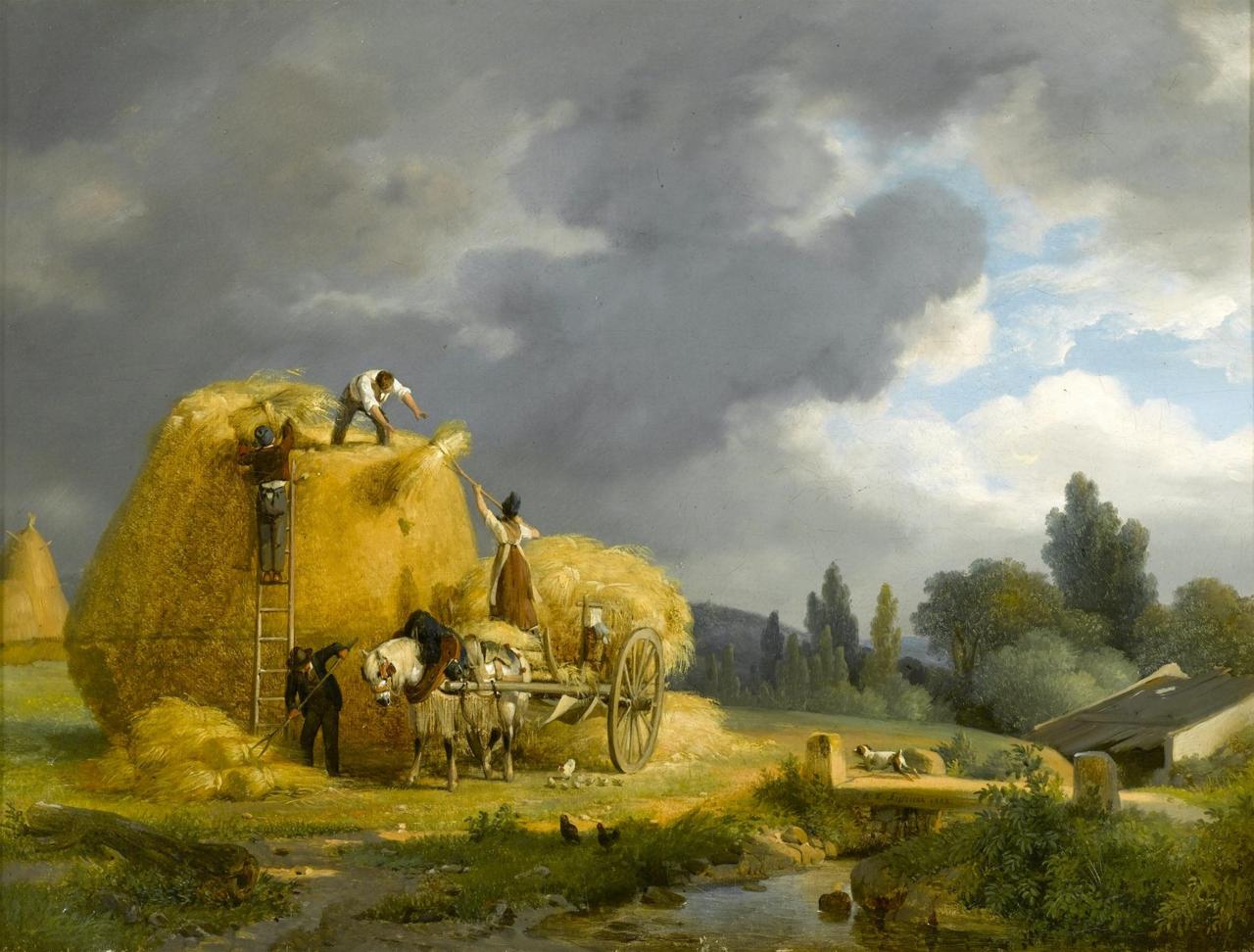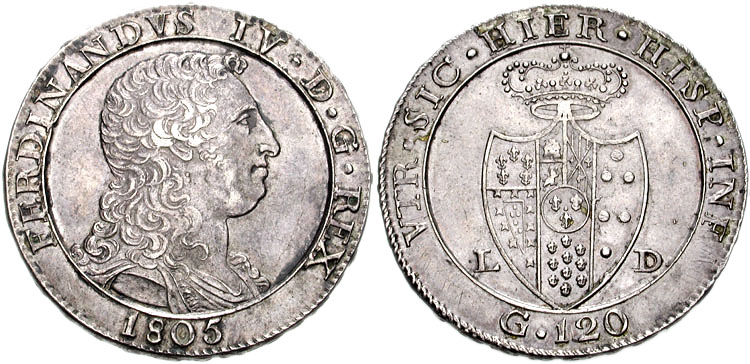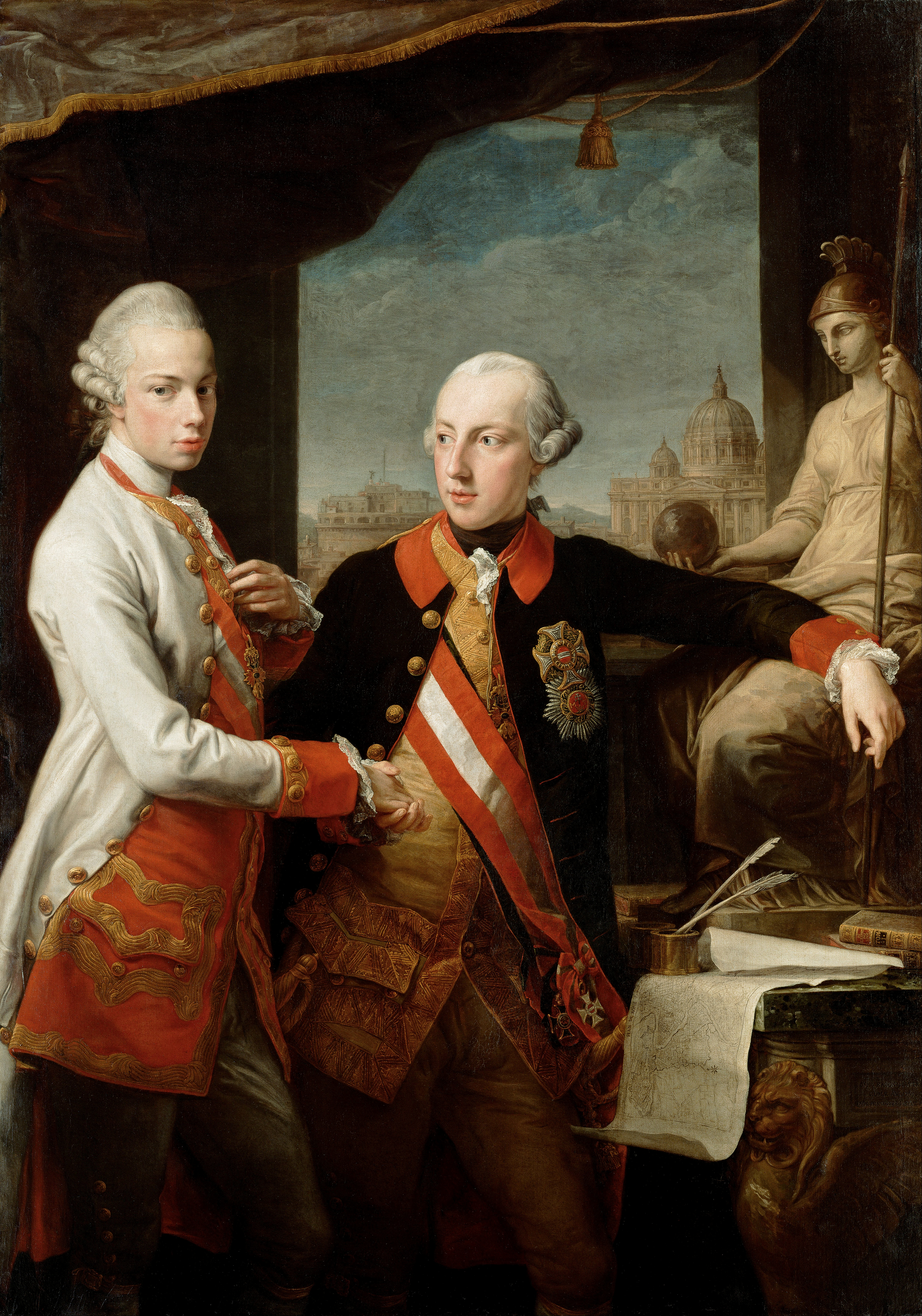|
Marie-Caroline Of Bourbon-Two Sicilies, Duchess Of Berry
Marie-Caroline of Bourbon-Two Sicilies, Duchess of Berry (Maria Carolina Ferdinanda Luise; 5 November 1798 – Brunsee, Styria, Austria 16 April 1870) was an Italian princess of the House of Bourbon who married into the French royal family, and was the mother of Henri, Count of Chambord. She led an unsuccessful rebellion against King Louis-Philippe I to install her son on the French throne. Early life Caroline was born at Caserta Palace in Naples. She was the eldest child of Prince Francesco, the future King Francis I of the Two Sicilies, and his first wife, Archduchess Maria Clementina of Austria, the tenth child and third daughter of Emperor Leopold II and Maria Luisa of Spain. Her parents were double first cousins. Caroline was baptised with the names of her paternal grandparents, Maria Carolina of Austria and King Ferdinand IV of Naples, as well as her maternal grandmother Empress Maria Luisa. She spent her youth in Palermo and in Naples. Her mother died in 1801; her ... [...More Info...] [...Related Items...] OR: [Wikipedia] [Google] [Baidu] |
Duchess Of Berry
Duke of Berry () or Duchess of Berry () was a title in the Peerage of France. The Berry, France, Duchy of Berry, centred on Bourges, was originally created as an appanage for junior members of the House of France, French royal family and was frequently granted to female royals. The style "Duke of Berry" was later granted by several House of Bourbon, Bourbon monarchs to their grandsons. The last official Duke of Berry was Charles Ferdinand, Duke of Berry, Charles Ferdinand of Artois, son of Charles X of France, Charles X. The title Duke of Berry is currently being claimed through its usage as a courtesy title by Prince Alphonse de Bourbon, son of Louis Alphonse de Bourbon, Prince Louis, Duke of Anjou, the Legitimists, Legitimist claimant to the French Throne. House of Valois (1360-1505) On October 1360, King John II of France, John II created the peerage-duchy of Berry as an appanage for his third-born son, John, Duke of Berry, John of Poitiers, perhaps on the occasion of his marr ... [...More Info...] [...Related Items...] OR: [Wikipedia] [Google] [Baidu] |
Francis I Of The Two Sicilies
Francis I of the Two Sicilies (; 19 August 1777 – 8 November 1830) was King of the Two Sicilies from 1825 to 1830 and regent of the Kingdom of Sicily from 1806 to 1814. Early life Francis was born the son of Ferdinand I of the Two Sicilies and his wife Archduchess Maria Carolina of Austria in Naples. He was also the nephew of Marie Antoinette and Louis XVI, the last King and Queen of France before the first French Republic, and grandson of Empress Maria Theresa, the Empress of Habsburg and Holy Roman Empress. At the death of his older brother Carlo, Duke of Calabria in 1778, Francis became the heir-apparent to the thrones of Naples and Sicily with the title ''Duke of Calabria'', the traditional title of the heir apparent to the Neapolitan throne. Later life In 1796 Francis married his double first cousin Archduchess Maria Clementina of Austria, daughter of Leopold II, Holy Roman Emperor. When she died in 1801, he married his paternal first cousin María Isabell ... [...More Info...] [...Related Items...] OR: [Wikipedia] [Google] [Baidu] |
Kingdom Of The Two Sicilies
The Kingdom of the Two Sicilies () was a kingdom in Southern Italy from 1816 to 1861 under the control of the House of Bourbon-Two Sicilies, a cadet branch of the House of Bourbon, Bourbons. The kingdom was the largest sovereign state by population and land area in Italy before the Italian unification, comprising Sicily and most of the area of today's ''Mezzogiorno'' (southern Italy) and covering all of the Italian peninsula south of the Papal States. The kingdom was formed when the Kingdom of Sicily merged with the Kingdom of Naples, which was officially also known as the Kingdom of Sicily. Since both kingdoms were named Sicily, they were collectively known as the "Two Sicilies" (''Utraque Sicilia'', literally "both Sicilies"), and the unified kingdom adopted this name. The king of the Two Sicilies was Expedition of the Thousand, overthrown by Giuseppe Garibaldi in 1860, after which the people voted in a plebiscite to join the Kingdom of Sardinia (1720–1861), Kingdom of Sardi ... [...More Info...] [...Related Items...] OR: [Wikipedia] [Google] [Baidu] |
Pierre Louis Jean Casimir De Blacas
Pierre-Louis Jean Casimir, Count of Blacas d'Aulps (10 January 1771 – 17 November 1839), later created 1st Duke of Blacas (1821), was a French antiquarian, nobleman and diplomat during the Bourbon Restoration. Biography Early life He was baptized at Avignon on 11 January 1771. He was the son of an aristocrat from Provence and took an opposing view of the French Revolution. In 1790, while a sous-lieutenant in the Noailles dragoons from Tarn, he fled across the Var to Nice in the Kingdom of Sardinia. From there, he went to the German frontier town of Coblenz and joined the counter-revolutionary ''émigré'' army of Louis XVI's cousin, the Prince of Condé. Later, he went through Italy before entering the service of Russia and fighting the French Republic in Switzerland under Alexander Suvorov. Serving the Bourbons While in the pay of Austria, he then travelled to Warsaw and rejoined the court-in-exile of the pretender to the throne of France, King Louis XVI's younger ... [...More Info...] [...Related Items...] OR: [Wikipedia] [Google] [Baidu] |
Maria Isabella Of Spain
Maria may refer to: People * Mary, mother of Jesus * Maria (given name), a popular given name in many languages Place names Extraterrestrial * 170 Maria, a Main belt S-type asteroid discovered in 1877 * Lunar maria (plural of ''mare''), large, dark basaltic plains on Earth's Moon Terrestrial *Maria, Maevatanana, Madagascar * Maria, Quebec, Canada * Maria, Siquijor, the Philippines * María, Spain, in Andalusia * Îles Maria, French Polynesia *María de Huerva, Aragon, Spain * Villa Maria (other) Arts, entertainment, and media Films * ''Maria'' (1947 film), Swedish film * ''Maria'' (1975 film), Swedish film * ''Maria'' (2003 film), Romanian film * ''Maria'' (2019 film), Filipino film * ''Maria'' (2021 film), Canadian film directed by Alec Pronovost *'' Being Maria'', 2024 French film released as ''Maria'' in France * ''Maria'' (2024 film), American film * ''Maria'' (Sinhala film), Sri Lankan upcoming film Literature * ''María'' (novel), an 1867 novel by Jorge Isaacs * ... [...More Info...] [...Related Items...] OR: [Wikipedia] [Google] [Baidu] |
Palermo
Palermo ( ; ; , locally also or ) is a city in southern Italy, the capital (political), capital of both the autonomous area, autonomous region of Sicily and the Metropolitan City of Palermo, the city's surrounding metropolitan province. The city is noted for its history, culture, architecture and gastronomy, playing an important role throughout much of its existence; it is over 2,700 years old. Palermo is in the northwest of the island of Sicily, by the Gulf of Palermo in the Tyrrhenian Sea. The city was founded in Isla Palermo 734 BC by the Phoenicians as ("flower"). Palermo then became a possession of Ancient Carthage, Carthage. Two ancient Greeks, Greek ancient Greek colonization, colonies were established, known collectively as ; the Carthaginians used this name on their coins after the 5th centuryBC. As , the town became part of the Roman Republic and Roman Empire, Empire for over a thousand years. From 831 to 1072 the city was under History of Islam in south ... [...More Info...] [...Related Items...] OR: [Wikipedia] [Google] [Baidu] |
Ferdinand IV Of Naples
Ferdinand I ( Italian: ''Ferdinando I''; 12 January 1751 – 4 January 1825) was King of the Two Sicilies from 1816 until his death. Before that he had been, since 1759, King of Naples as Ferdinand IV and King of Sicily as Ferdinand III. He was deposed twice from the throne of Naples: once by the revolutionary Parthenopean Republic for six months in 1799, and again by a French invasion in 1806, before being restored in 1815 at the end of the Napoleonic Wars. Ferdinand was born in Naples as the third son of King Charles VII and Queen Maria Amalia. In August 1759, Charles succeeded his half-brother Ferdinand VI of Spain as King Charles III, but treaty provisions made him ineligible to hold all three crowns. On 6 October, he abdicated his Neapolitan and Sicilian titles in favour of his third son, Ferdinand, because his eldest son Philip had been excluded from succession due to intellectual disability and his second son Charles was heir-apparent to the Spanish throne. Ferdinand ... [...More Info...] [...Related Items...] OR: [Wikipedia] [Google] [Baidu] |
Maria Carolina Of Austria
Maria Carolina of Austria (Maria Carolina Louise Josepha Johanna Antonia; 13 August 1752 – 8 September 1814) was Queen of Naples and Sicily as the wife of King Ferdinand IV and III, who later became King of the Two Sicilies. As ''de facto'' ruler of her husband's kingdoms, Maria Carolina oversaw the promulgation of many reforms, including the revocation of the ban on Freemasonry, the enlargement of the navy under her favorite, Sir John Acton, and the expulsion of Spanish influence. She was a proponent of enlightened absolutism until the advent of the French Revolution, when, in order to prevent its ideas gaining currency, she made Naples a police state. Born an archduchess of Austria, the thirteenth child of Empress Maria Theresa and Holy Roman Emperor Francis I, Maria Carolina married Ferdinand as part of an Austrian alliance with Spain, of which Ferdinand's father was king. Following the birth of a male heir in 1775, Maria Carolina was admitted to the Privy Counc ... [...More Info...] [...Related Items...] OR: [Wikipedia] [Google] [Baidu] |
Maria Luisa Of Spain
Infanta Maria Luisa of Spain ( Spanish: ''María Luisa'', German: ''Maria Ludovika''; 24 November 1745 – 15 May 1792) was Holy Roman Empress, German Queen, Queen of Hungary and Bohemia, and Grand Duchess of Tuscany as the spouse of Leopold II, Holy Roman Emperor. Early life Maria Luisa was born in Portici, in Campania, the site of the summer palace ('' Reggia di Portici'') of her parents, Charles, King of Naples and Sicily, and Maria Amalia of Saxony on 24 November 1745, on her mother's 21st birthday. She was the fifth daughter, and second surviving child, of her parents. Her father, the future Charles III of Spain, had become King of Naples and Sicily in 1735 after its occupation by the Spanish in the War of Polish Succession. After her father became King of Spain at the death of her half-uncle, Ferdinand VI of Spain, in 1759, she became known as ''Infanta Maria Luisa of Spain'', and she moved with her family to Spain. Grand Duchess of Tuscany Maria Luisa was originally ... [...More Info...] [...Related Items...] OR: [Wikipedia] [Google] [Baidu] |
Emperor Leopold II
Leopold II (Peter Leopold Josef Anton Joachim Pius Gotthard; 5 May 1747 – 1 March 1792) was the penultimate Holy Roman Emperor, as well as King of Hungary, Croatia and Bohemia, and Archduke of Austria from 1790 to 1792, and Grand Duke of Tuscany from 1765 to 1790. He was a son of Empress Maria Theresa and Emperor Francis I, and the brother of Queen Marie Antoinette of France, Queen Maria Carolina, Duchess Maria Amalia of Parma, and Emperor Joseph II. Leopold was a moderate proponent of enlightened absolutism like his brother Joseph II. He granted the Academy of Georgofili his protection. Unusually for his time, he opposed the death penalty and torture and abolished it in Tuscany on 30 November 1786 during his rule there, making it the first nation in modern history to do so. This act has been commemorated since 2000 by a regional custom known as the Feast of Tuscany, held every 30 November. Despite his brief reign, he is highly regarded. The historian Paul W. Schroeder call ... [...More Info...] [...Related Items...] OR: [Wikipedia] [Google] [Baidu] |
Naples
Naples ( ; ; ) is the Regions of Italy, regional capital of Campania and the third-largest city of Italy, after Rome and Milan, with a population of 908,082 within the city's administrative limits as of 2025, while its Metropolitan City of Naples, province-level municipality is the third most populous Metropolitan cities of Italy, metropolitan city in Italy with a population of 2,958,410 residents, and the List of urban areas in the European Union, eighth most populous in the European Union. Naples metropolitan area, Its metropolitan area stretches beyond the boundaries of the city wall for approximately . Naples also plays a key role in international diplomacy, since it is home to NATO's Allied Joint Force Command Naples and the Parliamentary Assembly of the Mediterranean. Founded by Greeks in the 1st millennium BC, first millennium BC, Naples is one of the oldest continuously inhabited urban areas in the world. In the eighth century BC, a colony known as Parthenope () was e ... [...More Info...] [...Related Items...] OR: [Wikipedia] [Google] [Baidu] |






